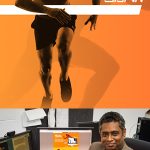 This year I’ve covered a number of interesting technologies that aim to track movement. For instance, a ‘smart suit‘ developed by Carnegie Mellon utilizes real-time motion capture and visualization tools to operate effectively in any lighting. The microsensors sewn into the suit allow for the smallest movements to be captured and measured.
This year I’ve covered a number of interesting technologies that aim to track movement. For instance, a ‘smart suit‘ developed by Carnegie Mellon utilizes real-time motion capture and visualization tools to operate effectively in any lighting. The microsensors sewn into the suit allow for the smallest movements to be captured and measured.
A team from Deakin University in Australia are the latest to release work in this area, with a device they refer to as a ‘Fitbit for biomechanics’.
The device, known as BioKin, weighs under 20 grams and aims to provide low-cost wireless motion capture. It’s designed to be easily attachable to clothing, and can use a range of wireless 3D motion sensors to ensure full body coverage.
Rich data
Unlike existing wearable performance monitors, the device aims to go far beyond simply measuring movement and instead provide feedback on everything from medical rehabilitation to a golfer’s swing via sensors that track even the smallest movements.
“BioKin was created to help doctors and clinicians better monitor the progress of patients with balance disorders, recovering from strokes, living with Parkinson’s disease, or regaining movement after surgery,” the team say. “The small, light units provide incredibly accurate data – pinpointing movement to a greater accuracy – that give a really clear picture of how a patient is progressing with their rehab.”
The BioKin units send data directly to both user and their medical team via a mobile app that’s designed to be very straightforward to use. This allows rehabilitation to be performed at home without time-consuming visits to your doctor or hospital.
“This lessens the strain on the medical system and saves time and money for patients, especially those living in regional or remote areas,” the team explain.
The system has already undergone preliminary trials and is currently undergoing clinical trials for balance and movement disorders, wrist and shoulder rehabilitation.
These secondary stage trials are taking place in a number of hospitals in Melbourne, with the team hoping that this will be the springboard for deploying BioKin beyond the medical sphere.
“Since BioKin hit the market earlier this year, we’ve been in discussions with horse trainers who plan to strap the unit to a horse’s leg to assess its range of movements,” they say.
Indeed, they believe that the applications are only really limited by the imagination, especially when external software developers begin to build for the device. There is an API available, but it is still early days in terms of effective partnerships.
The hardware side of things is extremely flexible, meaning that software developers can turn it to a wide range of uses. The team also hope to take BioKin overseas and expand internationally.